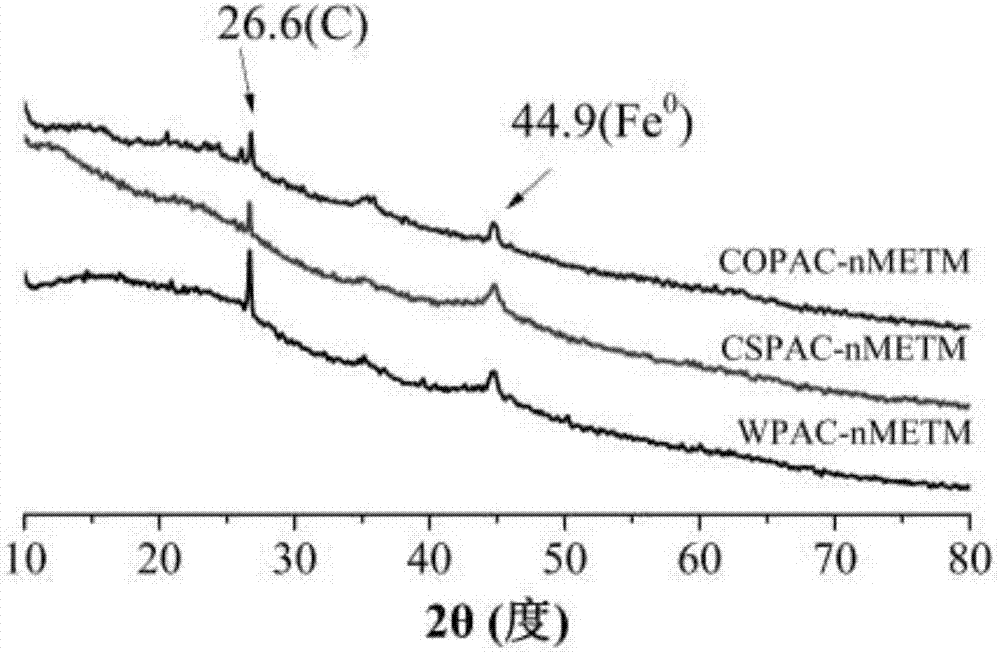Preparation method for nanometer microelectrolysis material used for removing tetracycline pollutants
A technology of tetracyclines and micro-electrolysis, which is applied in the direction of water pollutants, chemical instruments and methods, water/sewage treatment, etc., can solve the problems of high treatment cost, unoptimistic treatment status, incomplete mineralization, etc., and achieve rapid response, Quick removal effect, highly reactive effect
- Summary
- Abstract
- Description
- Claims
- Application Information
AI Technical Summary
Problems solved by technology
Method used
Image
Examples
Embodiment 1
[0028] Step 1: Pass WPAC through a 100-mesh sieve, soak in ultrapure water for 24 hours, put it in an oven at 120°C, and dry it for 2 hours before use. FeSO 4 ·7H 2 O the solid is ground and pulverized, and after passing through a 100-mesh sieve, it is set aside.
[0029] Step 2: take by weighing 3.268g of sodium borohydride (NaBH 4 ) into a beaker, and dissolve it with ultrapure water to prepare a 5mol / L sodium borohydride solution, which is named as preformed solution A.
[0030] Step 3: Weigh 10.000g of FeSO 4 ·7H 2 The O solid was dissolved in a 150mL 4 / 1 (v / v) ethanol / water mixed solution in a beaker, then placed in an ultrasonic cleaner for 10min, and then 0.864g (FeSO 4 ·7H 2 The mass ratio of O to activated carbon is 1:2) WPAC is added to the above mixed solution, and then ultrasonicated for 15 minutes, so that WPAC and the mixed solution are fully mixed, and the prefabricated solution B is prepared.
[0031] Step 4: Slowly add the prefabricated solution A solut...
Embodiment 2
[0039] Step 1: Pass CSPAC through a 100-mesh sieve, soak it in ultrapure water for 24 hours, put it in an oven at 120°C, and dry it for 2 hours before use. FeSO 4 ·7H 2 O The solid is ground and pulverized, and passed through a 100-mesh sieve for subsequent use.
[0040] Step 2: take by weighing 3.268g of sodium borohydride (NaBH 4 ) into a beaker, and dissolve it with ultrapure water to prepare a 5mol / L sodium borohydride solution, which is named as preformed solution A.
[0041] Step 3: Weigh 10.000g of FeSO 4 ·7H 2 The O solid was dissolved in a 150mL 4 / 1 (v / v) ethanol / water mixed solution in a beaker, then placed in an ultrasonic cleaner for 10min, and then 0.864g (FeSO 4 ·7H 2 The molar ratio of O to activated carbon is 1:2) CSPAC is added to the above mixed solution, and then ultrasonicated for 15 minutes, so that WPAC and the mixed solution are fully mixed, and the prefabricated solution B is prepared.
[0042] Step 4: Slowly add the prefabricated solution A solu...
Embodiment 3
[0048] Step 1: Pass COPAC through a 100-mesh sieve, soak it in ultrapure water for 24 hours, put it in an oven at 120°C, and dry it for 2 hours before use. FeSO 4 ·7H 2 O The solid is ground and pulverized, and passed through a 100-mesh sieve for subsequent use.
[0049] Step 2: take by weighing 3.268g of sodium borohydride (NaBH 4 ) into a beaker, and dissolve it with ultrapure water to prepare a 5mol / L sodium borohydride solution, which is named as preformed solution A.
[0050] Step 3: Weigh 10.000g of FeSO 4 ·7H 2 The O solid was dissolved in a 150mL 4 / 1 (v / v) ethanol / water mixed solution in a beaker, then placed in an ultrasonic cleaner for 10min, and then 0.864g (FeSO 4 ·7H 2 The molar ratio of O to activated carbon is 1:2) COPAC is added to the above mixed solution, and then ultrasonicated for 15 minutes, so that WPAC and the mixed solution are fully mixed, and the prefabricated solution B is prepared.
[0051] Step 4: Slowly add the prefabricated solution A solu...
PUM
 Login to View More
Login to View More Abstract
Description
Claims
Application Information
 Login to View More
Login to View More - R&D
- Intellectual Property
- Life Sciences
- Materials
- Tech Scout
- Unparalleled Data Quality
- Higher Quality Content
- 60% Fewer Hallucinations
Browse by: Latest US Patents, China's latest patents, Technical Efficacy Thesaurus, Application Domain, Technology Topic, Popular Technical Reports.
© 2025 PatSnap. All rights reserved.Legal|Privacy policy|Modern Slavery Act Transparency Statement|Sitemap|About US| Contact US: help@patsnap.com



